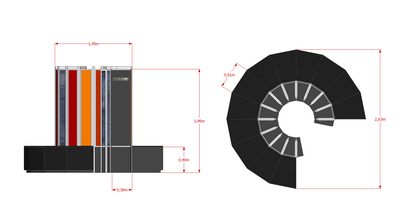Cray-1
It is perhaps best known for its unique shape, a relatively small C-shaped cabinet with a ring of benches around the outside covering the power supplies and the cooling system.The 8600 was essentially made up of four 7600s in a box with an additional special mode that allowed them to operate lock-step in a SIMD fashion.Jim Thornton, formerly Cray's engineering partner on earlier designs, had started a more radical project known as the CDC STAR-100.The main processor of the STAR had lower performance than the 7600, but added hardware and instructions to speed up particularly common supercomputer tasks.In the back yard of the land he purchased in Chippewa Falls, Cray and a group of former CDC employees started looking for ideas.The machine made Seymour Cray a celebrity and his company a success, lasting until the supercomputer crash in the early 1990s.A more conservatively designed evolutionary successor of the Cray-1 and X-MP models was therefore made by the name Cray Y-MP and launched in 1988.Typical scientific workloads consist of reading in large data sets, transforming them in some way and then writing them back out again.First it reads the instruction from memory and decodes it, then it collects any additional information it needs, in this case the numbers b and c, and then finally runs the operation and stores the results.Because the data layout is in a known format — a set of numbers arranged sequentially in memory — the pipelines can be tuned to improve the performance of fetches.On the receipt of a vector instruction, special hardware sets up the memory access for the arrays and stuffs the data into the processor as fast as possible.That meant the machine incurred a high cost when switching from processing vectors to performing operations on non-vector operands.He decided that in addition to fast vector processing, his design would also require excellent all-around scalar performance.In 1978, a team from the Argonne National Laboratory tested a variety of typical workloads on a Cray-1 as part of a proposal to purchase one for their use, replacing their IBM 370/195.Each cable between the modules was a twisted pair, cut to a specific length in order to guarantee the signals arrived at precisely the right time and minimize electrical reflection.The copper sheet conducted heat to the edges of the cage, where liquid Freon running in stainless steel pipes drew it away to the cooling unit below the machine.The first Cray-1 was delayed six months due to problems in the cooling system; lubricant that is normally mixed with the Freon to keep the compressor running would leak through the seals and eventually coat the boards with oil until they shorted out.(The reciprocal approximation unit could also operate in parallel, but did not deliver a true floating-point result - two additional multiplications were needed to achieve a full division.)Earlier Cray designs at CDC had included separate computers dedicated to this task, but this was no longer needed.At the European Centre for Medium-Range Weather Forecasts, which was one of the first customers, the mean time between hardware faults was reported to be 96 hours in 1979.Similarly, the Cray Operating System (COS) was fairly rudimentary, hardly tested and updated weekly or even daily in the early days.CTSS was written in a dynamic memory Fortran, first named LRLTRAN, which ran on CDC 7600s, renamed CVC (pronounced "Civic") when vectorization for the Cray-1 was added.This act would later give CRI a six-month head start on the Cray-2 Unix port to ETA Systems' detriment, and Lucasfilm's first computer generated test film, The Adventures of André & Wally B..The few exceptions were climatological and meteorological programs until the NSF responded to the Japanese Fifth Generation Computer Systems project and created its supercomputer centers.


Science MuseumCray ResearchSeymour CrayFront-endData General EclipseOperating systemUNICOS64-bitMemoryMegabytesStorageCray X-MPsupercomputerLos Alamos National Laboratoryvector processorregistersCDC STAR-100Control Data CorporationCDC 8600CDC 6600CDC 7600lock-stepWilliam NorrisChippewa FallsChief Technology OfficerWall StreetLawrence Livermore National LaboratoryNational Center for Atmospheric ResearchWilliam PerrycryptanalysisMFLOPSCray-2Cray Y-MPGoogleNexus 10HTC OneA13 processoriPhone 11until 1994instruction pipelineassembly lineVector processorsAmdahl's lawArgonne National LaboratoryIBM 370/195Boulder, ColoradoQ clearancefast Fourier transformintegrated circuitsNOR gatefanoutstatic RAMFairchild SemiconductorMotorolaprinted circuit boardstwisted pairinterleaved memorypopulation countData GeneralSuperNova S/200Cray Operating SystemEuropean Centre for Medium-Range Weather ForecastsSolid-state Storage Deviceautomatically vectorizingFortranUnited States Department of EnergyLos Alamos Scientific LaboratorySandia National LaboratoriesNational Science FoundationCray Time Sharing SystemCDC 7600sminisupercomputersNational Security AgencyNetlibBell LaboratoriesETA SystemsLucasfilmThe Adventures of André & Wally B.Fifth Generation Computer Systems projectCray BlitzWorld Computer Chess ChampionshipNorth American Computer Chess Championship ChessBradbury Science MuseumLos Alamos, New MexicoChippewa Falls, WisconsinCray Inc.Cray PlazaSt. Paul, MinnesotaComputer History MuseumMountain View, CaliforniaComputer Museum of AmericaRoswell, GeorgiaDigiBarn Computer MuseumDeutsches MuseumMunichETH ZurichZürichSwitzerlandSeattle, WashingtonNational Air and Space MuseumWashington, D.C.Musée BoloLausanneThe National Museum of ComputingBletchley ParkLondonSwedish National Museum of Science and TechnologyStockholm, SwedenSystem Source Computer MuseumHunt Valley, MarylandValladolid Science MuseumScience Museum, LondonWayback MachineDesign NewsThe New York TimesWorld's most powerful supercomputerCray XMSCray Y-MP ELCray C90Cray EL90Cray T3DCray J90Cray T90Cray T3ECray SV1